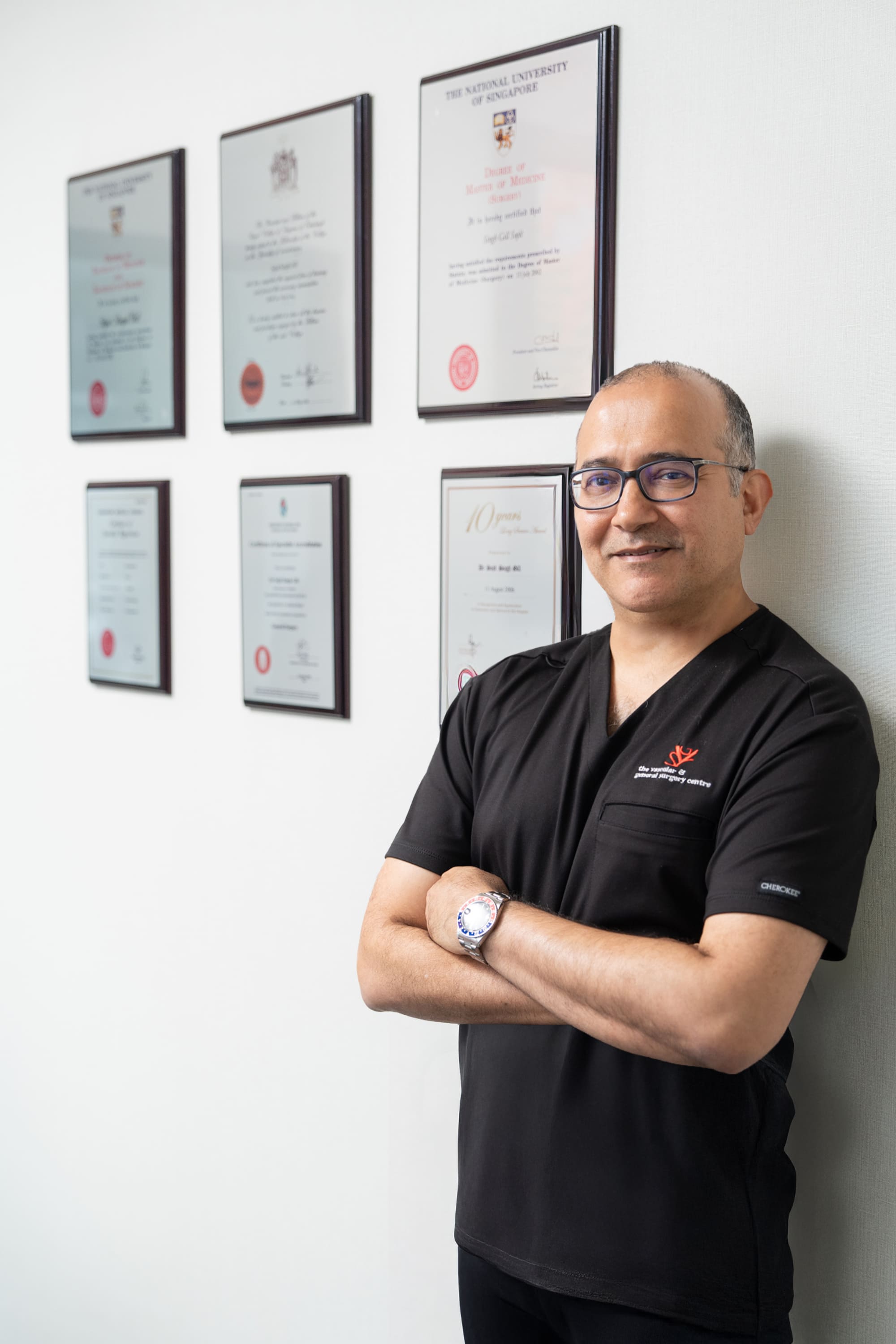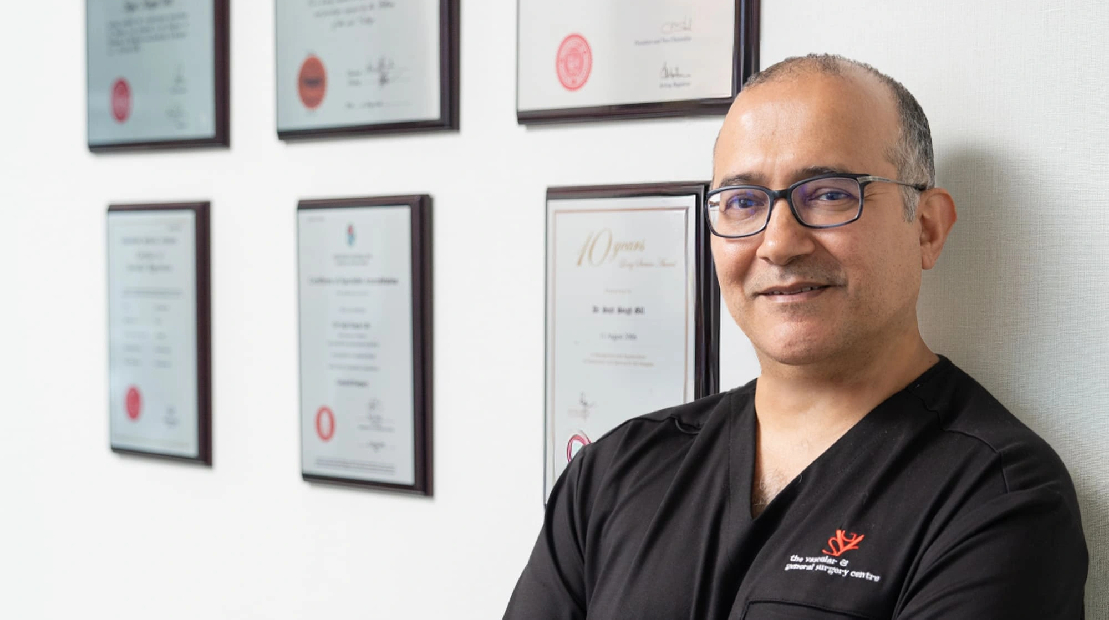
For a consultation, please contact us at +65 6736 2302 or fill up the form below and we will get back to you as soon as possible

For a consultation, please contact us at +65 6736 2302 or fill up the form below and we will get back to you as soon as possible

Peripheral Arterial Disease (PAD) refers to narrowing in the arteries in the legs. The arteries serve to transport oxygen-rich blood to the peripheries- the hands, feet etc. When the arteries are narrowed, the flow of blood is slowed, much like how traffic in a four-lane highway is slowed if an accident causes blockage of two lanes of the highway, or how flow through a clogged pipe is slowed.
The peripheries can cope well with a slight reduction in flow. However, if the narrowing worsens further, the flow of blood becomes insufficient to meet the needs of the limb. For example, the diseased artery may allow sufficient flow to nourish the limb when it is at rest. But when the limb is exercising there is a greater demand for oxygen, which the arteries may not be able to deliver. This results in pain on exercising.
As the narrowing progresses further, the flow of blood may not even be able to meet the needs of a limb at rest. The patient develops “rest pain”, or pain in the limbs due to insufficient oxygen and nutrient supplies. Further progression or complete blockage of the arteries leads to gangrene which is death of the tissue such as a toe, or ulcer formation which is death of skin which is unable to heal itself. This is a serious condition known as Critical Limb Ischaemia (CLI) and if not treated can lead to limb loss or even loss of life.
Atherosclerosis is a build-up of plaque within the walls of the arteries. Atherosclerosis is the same disease process that causes heart attacks. It can affect any artery in the body. Affecting the coronary arteries leads to heart attacks. Affecting the limb arteries results in PAD.
Atherosclerosis is common in patients:
The thing is, PAD doesn't always show symptoms, especially in the early stages. But it's real. It's possible that you may have it right now without even knowing it.
Burning or aching in feet and toes- this happens while resting. Many diabetics mistake this for neuropathy, or nerve pain.
Coolness of the skin of the limbs- the skin of the feet feel cooler to touch. The colour of the skin may be more blue than normal.
Sores or ulcers- these are breaks in the skin of the feet that do not heal as there is insufficient oxygen and nutrition reaching this area. There are at high risk of getting infected.
Painful leg cramps while walking- the cramps in the calf occur during walking and are relieved by rest. It is a condition called intermittent claudication.
Gangrene- the skin of the feet or toes turns black. This means that tissue death has occured. This tissue cannot recover. However, urgent treatment is necessary to make sure the gangrene does not progress to involve other toes or the whole foot.
If the risk factors are identifies early enough, aggressive control of these risks should be implemented. Blood pressure must be well-controlled, as must the blood sugar levels in diabetics. The patient should stop smoking, should implement dietary changes and should embark on an exercise regime. Implementing these steps can reduce the risk of PAD.
For patients with established PAD, we have additional tools in our armamentarium. Most of the blocked or narrowed arteries can be reopened during a procedure known as Angioplasty. Angioplasty involves inserting a small tube into the diseased artery, placing a deflated balloon across the plaque or blockages and inflating this balloon hence compressing or flattening the plaque against the arterial wall. This widens the channel available, improving blood flow. Sometimes a metal scaffolding known as a Stent is placed to help maintain the size of the channel and to prevent plaque from forming again.
In rare cases, the artery cannot be reopened during angioplasty. In these situations bypass surgery is necessary. Bypass surgery is where a blood vessel is placed under the skin connecting healthy artery above a blockage to healthy artery below it. The blood flows through this new channel bypassing the blockage into healthy artery beyond the blockage.
Unfortunately, PAD cannot be cured. Medical treatment and a healthy lifestyle can help improve blood flow and help keep the disease from getting worse. Taking action against PAD and CLI while these conditions are still manageable may help reduce leg pain and the risk of serious complications, including the risk of amputation, heart attack, stroke, and cardiovascular disease. That’s great news for you and your loved ones.
You will require a health history and complete physical examination to assess the severity of the PAD. You should provide a history of all medical conditions you may be suffering from, as well as all medications you are currently taking for example diabetes medication or hypertension medication.
As part of the physical examination, an ultrasound scan may be performed to localise the level and/or extent of the narrowing of the arteries. Sometimes a scan known as a CT Angiogram is performed which gives us a better look at arteries within the pelvis.
If you indeed have significant PAD or CLI, you will need some form of revascularisation. This is where either Angioplasty or Bypass comes into the picture.
Angioplasty is a minimally-invasive procedure that requires only the insertion of a needle into the skin. There is no surgical incision. Because the needle is small only local anaesthesia is needed.
Because it is minimally-invasive, the recovery from the procedure is much faster than after surgery. In fact, many patients are able to leave the hospital the day after the procedure.


Dr Sujit Singh Gill is the medical director and consultant surgeon at The Vascular and General Surgery Centre, providing dedicated and evidence-based care for patients with various vascular and other conditions in Singapore. His expertise lies in peripheral arterial disease, varicose veins, diabetic vascular complications, hernia repair, gastroscopy, and colonoscopy. With his advanced training and a patient-focused approach, Dr Gill ensures that his patients receive effective, tailored treatments for better outcomes.
More About Dr Gill
The Vascular & General Surgery Centre
Unit 18-05, Paragon Medical Suites, 290 Orchard Road, Singapore 238859
Tel: +65 6736 2302
Fax: +65 6736 4186
Whatsapp : +65 8866 7837
Email: enquiry@tvgsc.sg
24-hour Answering Service : +65 6535 8833
Blog
NEED ASSISTANCE
Have a question or wish to
make an appointment?
We're here to help.